Artist Andy Warhol shot over 500 silent, black-and-white screen-tests in his famous Factory between 1964 and 1966, documenting the beautiful youth who were drawn to the scene. Sometimes he would chat with the subject beforehand, offering suggestions to help them achieve the type of performance he was looking for. More frequently he took a passive role, to the point of leaving the room during the filming.
The opposite of a people person, he preferred to engage with his subjects by scrutinizing the finished screen tests, projecting them in slow motion to imbue them with an added element of glamour and amplify every nuance of expression. As Warhol wrote in The Philosophy of Andy Warhol:
That screen magnetism is something secret. If you could figure out what it is and how you make it, you’d have a really good product to sell. But you can’t even tell if someone has it until you actually see them up there on the screen. You have to give screen tests to find out.
The screen tests are less auditions for roles in Warhol films than pieces of an ongoing project. Warhol played with them, assembling and reassembling them into collections which he screened under such fluid titles as 13 Most Beautiful Women and 13 Most Wanted Men. Some of his test subjects went on to achieve real stardom—Lou Reed, Dennis Hopper, and Bob Dylan…
Others’ fame is forever tied to the Factory.
Edie Sedgwick, above, one of his best known muses, was a troubled girl from a wealthy family. Unlike some of the moodier screen tests, Sedgwick’s is fully lit. She displays a genuine movie star’s poise, barely moving as the camera drinks her in. Her beauty appears untouched by the addictions and eating disorders that were already a driving force in her life.
Actress and painter Mary Woronov emerged unscathed from her time at the Factory. Like Sedgwick, she seemed comfortable with the idea of being observed doing nothing for an extended period. Recalling her screen test experience in an interview with Bizarre, she made it clear that the subjects were far from the center of attention:
Andy put you on a stool, then puts the camera in front of you. There are lots of people around usually. And then he turns the camera on, and he walks away, and all the people walk away too, but you’re standing there in front of this camera.
I saw Salvador Dali do one, it was really funny. It’s a very interesting film, because it’s a way of cracking open your personality and showing what’s underneath—only in a visual way, because there’s no talking, nothing. You just look at the camera. Salvador made this gigantic pose with his moustache blaring and everything, and he couldn’t hold the pose. Not for five minutes. And so at about minute four, he suddenly started looking very, very real.
The camera loves stillness, something model and singer Nico was unable to deliver in her screen test. Perhaps not such a problem when the director has plans to project in slow motion.
As he stated in POPism: The Warhol ’60s:
What I liked was chunks of time all together, every real moment… I only wanted to find great people and let them be themselves… and I’d film them for a certain length of time and that would be the movie.
Factory regular/interior decorator/photographer Billy Name told punk historian Legs McNeil in an interview that the screen tests served another purpose—to identify the fellow travelers from among the poor fits:
… it’s always cool to meet other artists, you know, to see if it’s somebody who’s going to be a peer or a compatriot, who you can play with and hang around with or not. Andy was doing a series of screen tests for his films, and we wanted everybody to do one: Dylan, Nico, Dennis Hopper, Susan Sontag, Donovan—everyone famous that came up to the Factory. We’d just film 16mm black-and-white portraits of the person sitting there for a few minutes. So our purpose was to have Dylan come up and do a screen test, so he could be part of the series. That was enough for us. But Dylan didn’t talk at all when we filmed him. I don’t think he liked us, ha, ha, ha!
Revolver Gallery, devoted exclusively to Warhol, has a gallery of screen-tests on their YouTube channel.
Related Content:
The Big Ideas Behind Andy Warhol’s Art, and How They Can Help Us Build a Better World
Andy Warhol’s ‘Screen Test’ of Bob Dylan: A Classic Meeting of Egos
Ayun Halliday is an author, illustrator, theater maker and Chief Primatologist of the East Village Inky zine. Join her in NYC on Monday, September 24 for another monthly installment of her book-based variety show, Necromancers of the Public Domain. Follow her @AyunHalliday.







